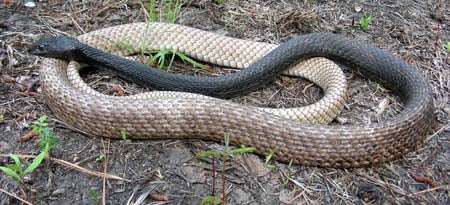Eastern Coachwhip article in Outdoor Alabama Magazine
SCIENTIFIC NAME:
Coluber flagellum flagellum
OTHER NAMES:
Whip snake
STATUS:
Formerly common, now declining and generally rare to uncommon, especially in northern Alabama. While some northern populations are feared extirpated, a few areas of scrubby or frequently burned Coastal Plain habitats still support fair numbers. MODERATE CONSERVATION CONCERN.
DESCRIPTION:
Eastern coachwhips are nonpoisonous snakes belonging to the family Colubridae. This family contains the majority of living snakes and is distributed essentially worldwide. Coachwhips are one of the largest snakes in North America. Adults average 50-72 inches long, but have been recorded up to 102 inches in length. Coachwhips are slender bodied snakes relative to their length. Their head and neck are typically black with the body gradually lightening to a tan colored tail. Some individuals may be uniformly tan or cream colored, and a melanistic (all black) phase occurs as well. Coachwhip’s bellies are of the same color as their backs, but sometimes have two rows of black dots running lengthwise of the body. They have large heads with strong jaws. Their large eyes have round pupils and are shielded from above by projecting ridges of scale. Their smooth scales and coloration on their long slim tails have the appearance of a braided whip. It is from this characteristic that coachwhips get their common name. These snakes are extremely fast (believed to be the fastest in North America) and are good climbers as well. When disturbed, they usually race away on the ground or climb into bushes or small trees. Sometimes, before fleeing they will vibrate the tip of their tail among the ground litter making a sound suggesting that of a rattlesnake. If cornered, coachwhips will strike repeatedly (often at their attackers face) and bite strongly if given the opportunity. Though aggressive in defense, these snakes will not chase a person down and “whip them to death” as a common legend suggests.
DISTRIBUTION:
Seven subspecies of coachwhips are recognized, which, as a group are widely distributed across the southern United States. While there is some disagreement among herpetologists regarding distribution and definition of these subspecies, it is certain that only one, M. f. flagellum, the eastern coachwhip, occurs in Alabama. Coachwhips occur statewide with the possible exception of a narrow band north of the Tennessee River. While once relatively common statewide, numbers are perceived to be declining. This is most evident in northern parts of the state where some populations may no longer exist. The eastern coachwhip is considered a species of concern in Alabama, and is protected by law.
HABITAT:
Coachwhips are most often found in dry, relatively open areas. Throughout their range they are known from a wide variety of habitats, including, but not restricted to rocky hillsides, grassland prairies, desert scrub, thorn forests, chaparral, pine and palmetto flatwoods, coastal dunes, cedar glades, exposed rock formations, edges between woodlands and fields, and longleaf pine-scrub oak sandhills. In Alabama, coachwhips have been most closely associated with upland situations having open grassy woodland interspersed with weedy fields. Scrubby, frequently burned, pine habitats in south Alabama seem to support the highest concentrations of coachwhips at this time. Gopher tortoise burrows may be used as shelter in areas where they are available.
FEEDING HABITS:
Coachwhips are active primarily during the day, prowling through the woods and fields they inhabit. These snakes seem to have an exceptional tolerance to heat, remaining active during the hottest portion of the hottest days of the year, even in desert or dune habitats. Coachwhips are opportunistic predators, readily feeding on grasshoppers, cicadas, other large insects, lizards, other snakes (including venomous species), birds, and small mammals. They frequently hunt with their heads raised well above the ground. This posture likely makes it easier for them to spot the movements of their prey. Coachwhips apparently can smell their prey and follow scent trails like many other snakes. Unlike most snakes, however, they seem, ultimately, to locate their prey visually by keying on its movement. Coachwhips capture prey with their powerful jaws which have rows of inward slanting tiny teeth. They do not constrict their prey to kill it, but simply grab it and eat it alive. Coachwhips sometimes beat their prey against the ground or other hard surface to stun it. These snakes feed frequently due to their high activity level.
LIFE HISTORY AND ECOLOGY:
Coachwhips are oviparous (they lay eggs) and clutch sizes average 10-16 oblong eggs (1-2 ¼ inches long) which have granular surfaces. Mating takes place in the spring with the female laying her eggs in June or July. Most clutches are located in rotting vegetation or logs and hatch 6 to 11 weeks after being laid. Hatchlings are typically 12-16 inches long and receive no known parental care. Newly hatched and young coachwhips are lighter colored than adults and have a pattern of dark bands across their backs. This banding pattern fades as it gets closer to the tail, and gradually fades completely with age.
REFERENCES:
“Alabama Natural Heritage Program. Alabama Herp Atlas Project: Checklist of the Amphibians and Reptiles of Alabama.”
“eNature: Coachwhip Masticophis flagellum.”
“Florida Museum of Natural History: Eastern Coachwhip Snake.”
Hill, K. 2001. “Smithsonian Marine Station at Fort Pierce: Dune Habitats.”
Mirarchi, R. E. 2004. Alabama Wildlife Volume One. The University of Alabama Press. Tuscaloosa, AL
Mount, R. H. 1975. The Reptiles & Amphibians of Alabama. Auburn Printing Co., Auburn, AL
Smith, C. 1996. “Desert USA: Reptiles of Anza-Borrego Desert.”
Sutton, A. and Sutton, M. 1985. The Audubon Society Nature Guides, Eastern Forests. Chanticleer Press, Inc., New York, NY
Wikipedia, the free encyclopedia: Masticophis flagellum.
Author:
John S. Powers, Area Wildlife Biologist, Division of Wildlife & Freshwater Fisheries






